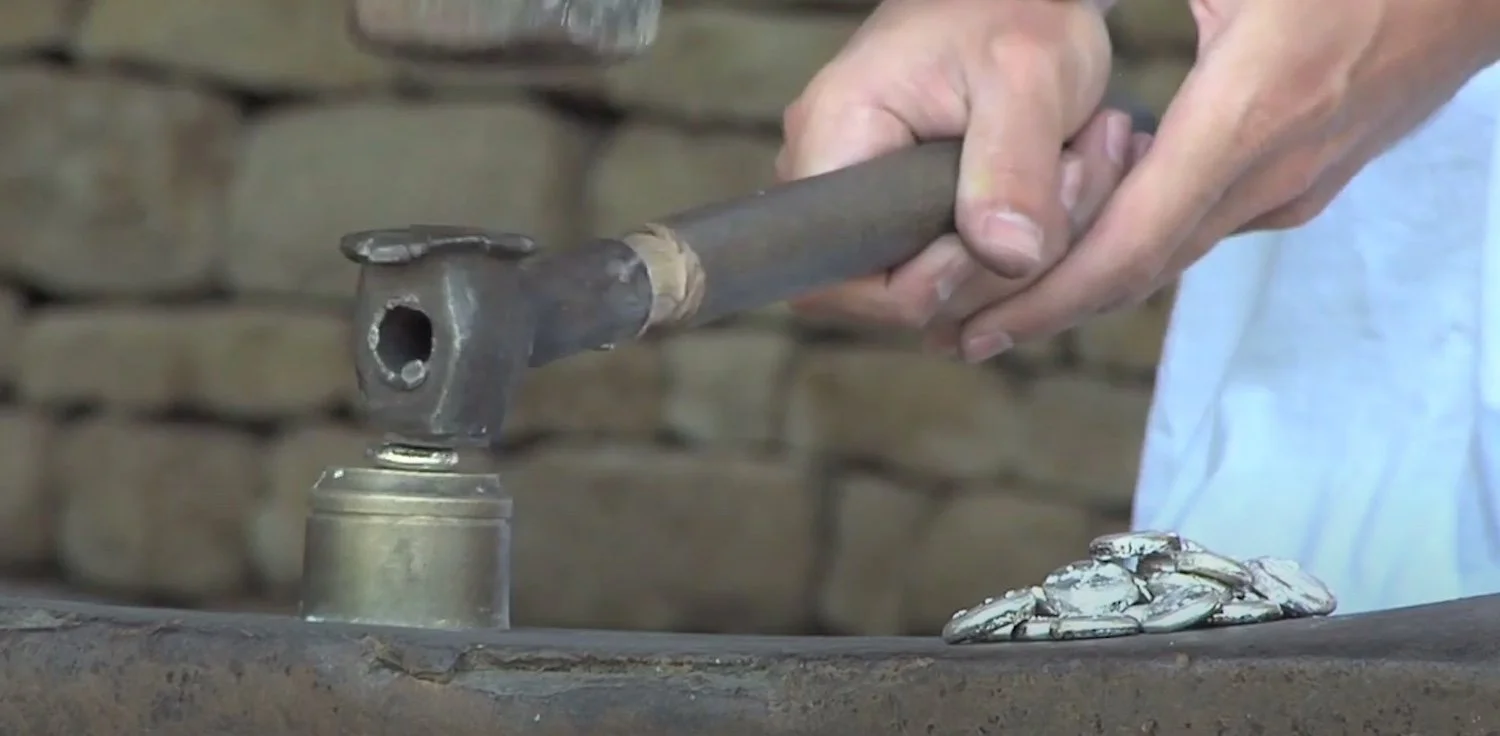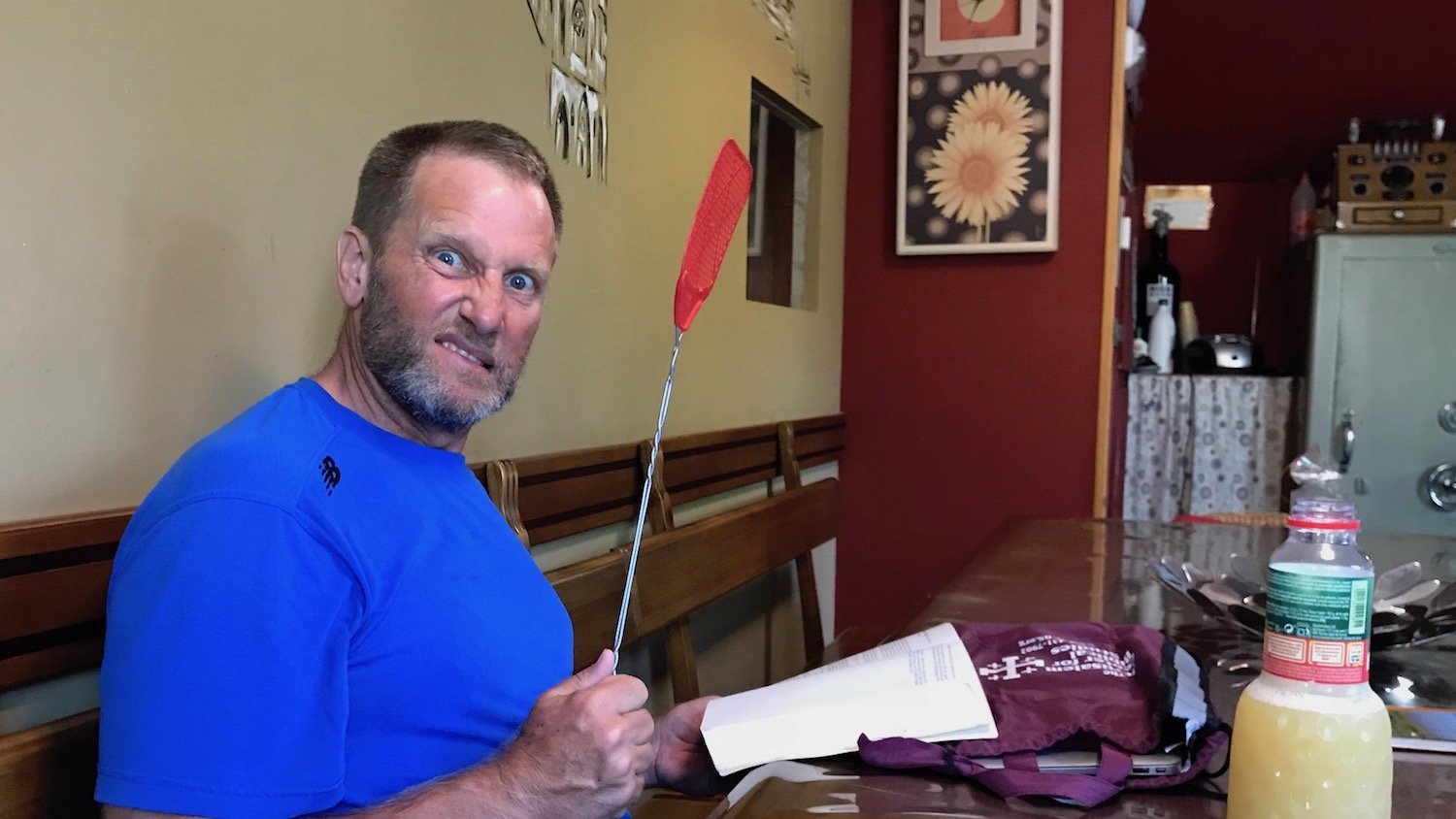There was not one hot and stuffy night in our Camino experience.
They were all hot and stuffy. It was July, after all, and we were in Spain. Still, as I remember it, one was was stuffiest of the stuffy. And this is how it happened.
Image courtesy of Google Earth.
Bob and I had made the haul up and out of Logroño, crossed a highland, and by late morning began a steady descent into the Río Najerilla basin. Red rocks, mesa-like, shimmered in the distance. According to the map, the village of Nájera was nestled out there somewhere.
Nájera took its name from the Arabic tongue. It is descriptive of its position, “between the rocks.” Before the arrival of Islam, the Romans called it Tritium Metallum.*
Tritium Metallum was significant enough to have its own mint in the second century BC. Metal disks or blanks were heated in an oven until soft. Then they were positioned in a two-sided die and hit with a hammer. The images from the die would be pressed into the heated blank. Thousands of these could be made each day by a muscly smith (to learn more about the process, watch the brief and interesting video linked here).
A Roman-era coin minted in Tritium Metallum. Image from here (accessed 12/10/2021). The spearman on horse offers a nice touch, don’t you think?
The temperature crept upward as Bob and I approached Nájera.
Tink—tink—tink. The silver cap of my walking stick tapped the stones.
Our conversation was reduced to grunts and gestures. The air was stale. Flies flew in circles.
I blinked and imagined I was somewhere in the American southwest. All that was needed to complete the picture was a bandito and a saguaro with arms upraised in surrender.
Instead of a cactus, a Camino scallop appeared on a sign beside the trail. It brought me back to my Old World senses. I unclipped my water bottle. It was hot. I drank it anyway.
After midday, we found Nájera and followed the signage through the industrial side of town. We passed the dust of a gravel yard, flour mill, paint store, and stations for automobile service and repair. The road narrowed. Closed storefronts, abandoned structures, and a few municipal buildings appeared. Finally, we crossed the Río Najerilla above some rapids. On the other bank, the town was compacted, pressed between the sky, the river, and a towering cliff face. The hostel we sought was open to the river.
Nájera is compacted by sky, river, and cliffs. Image from here (accessed 12/10/2021).
We checked in, parked out boots and sticks in the lobby, and chose our bunks in one of several small rooms. Bob favored the upper echelon; I usually went for the lower deck, and against a wall, if possible. I found an unclaimed spot in the corner. We rested, wrote, and hydrated. The flies circled.
One landed on the table where we were sitting. I caught him with the swoooosh of my hand. His wings buzzed in my fist.
“Bob, I caught a fly!”
He looked up from his phone. “No way.”
“Yes way.” I unfolded my fingers and he flew out.
“How’d you do that?”
I showed Bob the Ninja method of flycatching whereby you scoop the air above the spot where a fly is sitting. It doesn’t always work, but it sometimes does. We caught flies for a while.
Hydrating, writing, and killing flies.
The afternoon wore down and the hostel filled. There were perhaps 15 bunk beds in our room with a single window. The window remained open in the day, but as darkness fell, it was pulled shut.
I must confess: I was born and raised in a culture where fresh air was encouraged. To this day, we often sleep with a cracked window, even in the dead of winter. I struggle with the Mediterranean idea of miasma. Miasma, in the Greek tongue, might be translated as “pollution,” but in an Old World setting, is more deadly than dirty.** Up until recently, “miasma theory” (as opposed to “germ theory”) was embraced in many places, including Spain. “Miasma theory” suggests that human sickness and disease are communicated by foul smells and moving air, particularly at night. The solution: seal the room and eliminate the drafts. No matter how stuffy it becomes, you are better off in still space.***
Obviously, air conditioning is lethal and to be avoided at all costs.
(Sigh.)
The front door of the stuffiest hostel ever.
I lay on my corner bunk in the stuffiest of the stuffy rooms, squeezed like a hot Roman coin. I inhaled the noxious odors of my roommates.
I didn’t sleep a wink, but on the positive side, I didn’t catch any diseases either.****
¡Buen Camino!
*Tritium Metallum—not to be confused with Tritium Autrigonum near Burgos—is mentioned as one of few cities of consequence that belonged to the people-group known as the Berones. See Ptolemy’s Geography 2.6.55. The remains of Tritium Metallum are not found within Nájera proper, but about one mile to the SE in the adjacent village of Tricio (that preserves an element of its more ancient name).
**The word appears once in the New Testament. 2 Peter 2:20 describes a person who has escaped the defilements (μίασμα, miasma) of the world and learned about a saving faith, yet becomes entangled again with disastrous consequences. Here, the word connotes moral defilement.
In the broader Greek world, miasma is contagious and difficult to stop, short of a sacrifice. Whole books have been written on this, see Robert Parker’s Miasma: Pollution and Purification in Early Greek Religion. Clarendon, 1983. For a quick read on the history of miasma theory and disease, see the online essay by Ajesh Kannadan linked here (accessed 12/14/2021).
***“Spain was relatively slow to adopt germ theory in preference to miasma as the cause of disease, with miasma holding sway up to the turn of the twentieth century.” See Note 16 on page 165 of A. L. Six, Gothic Terrors: Incarceration, Duplication and Bloodlust in Spanish Narrative. (Bucknell, 2010).
****I wonder if and how the COVID-19 season will change the Camino experience? My engagement with the trail took place in the summer of 2018.
We have a full slate of Bible Land trips ready to launch in 2022. Check out a complete list by clicking here or peruse under the heading “Find your Trip.” For more information on how to join one of these trips or if you are interested in helping to craft a unique trip for your own group, church, or school, contact me at markziese@gmail.com.








